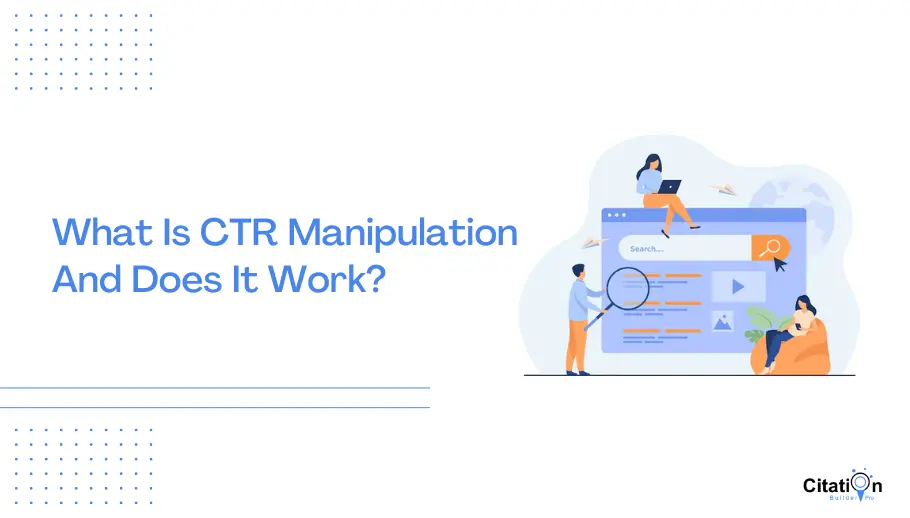Unlock Your Online Prospective with Professional CTR Manipulation Methods
Unlock Your Online Prospective with Professional CTR Manipulation Methods
Blog Article
Understanding CTR Control for Maximum Influence
In the digital landscape, understanding click-through price (CTR) control is necessary for taking full advantage of the effect of your content. Recognizing the essential elements that affect CTR, such as target market interaction and timing, can empower you to craft more reliable approaches.
Understanding Click-Through Rate
 Click-Through Price (CTR) is a vital statistics in digital marketing that evaluates the efficiency of on the internet promotions and web content in driving user interaction. It is determined by splitting the number of clicks an advertisement or link obtains by the number of times it is presented, then increasing by 100 to share it as a portion. A higher CTR shows that the web content resonates better with the target market, thus improving the general performance of electronic projects.
Click-Through Price (CTR) is a vital statistics in digital marketing that evaluates the efficiency of on the internet promotions and web content in driving user interaction. It is determined by splitting the number of clicks an advertisement or link obtains by the number of times it is presented, then increasing by 100 to share it as a portion. A higher CTR shows that the web content resonates better with the target market, thus improving the general performance of electronic projects.Understanding CTR is vital for marketers as it gives understandings right into user actions and choices. A low CTR may indicate that the content is not appealing or appropriate to the target market, triggering a need for reevaluation of placement, messaging, or design. Alternatively, a high CTR might highlight effective techniques, guiding future advertising initiatives.
Moreover, CTR acts as a relative tool to review various projects, allowing online marketers to maximize their method and designate sources effectively. By evaluating CTR fads, organizations can refine their content approaches, improve target market targeting, and inevitably achieve far better conversion prices. Hence, understanding CTR is indispensable to improving electronic marketing efficiency and driving lasting growth.
Key Variables Influencing CTR
A number of elements play a significant role in identifying the efficiency of CTR in digital advertising. Among one of the most significant elements is the relevance of the content to the target audience - LinkDaddy CTR Manipulation. Ads or web links that reverberate with the individuals' rate of interests and demands are more probable to gather clicks
An additional important factor is the high quality of the descriptions and headlines. Involving and engaging titles can record interest, while succinct and clear meta summaries can offer context that motivates individuals to click with. In addition, the placement of the web content, whether it's above the layer or integrated into a feed, can considerably influence exposure and, consequently, CTR.
Aesthetic aspects additionally add to CTR. Top notch photos or videos can enhance engagement, making the content much more attractive. Moreover, the use of call-to-action (CTA) buttons plays a crucial function; well-placed and influential CTAs can encourage users to act.
 Finally, audience segmentation is important. Customizing messages to specific demographics ensures that the material gets to the appropriate individuals, enhancing the opportunities of clicks. Comprehending these key elements is important for efficiently controling CTR in electronic advertising and marketing initiatives.
Finally, audience segmentation is important. Customizing messages to specific demographics ensures that the material gets to the appropriate individuals, enhancing the opportunities of clicks. Comprehending these key elements is important for efficiently controling CTR in electronic advertising and marketing initiatives.Efficient Approaches for Optimization
To enhance click-through rates successfully, online marketers must carry out a series of targeted approaches tailored to their audience. Crafting engaging headings is important; these ought to be succinct, appealing, and include appropriate key words that reverberate with the target group. A/B screening various headings can disclose which versions record focus most efficiently.
High-grade pictures or video clips that align with the web content can attract individuals' interest and encourage clicks. CTAs must produce a feeling of urgency or highlight a benefit, prompting immediate activity from the audience.
Another strategy is maximizing ad positioning and timing. Examining target market behavior information can help online marketers identify the very best times to deploy projects for optimum exposure. Additionally, individualizing web content based on customer choices and past interactions can promote a stronger connection and improve CTR.
Finally, preserving mobile optimization is crucial. With raising mobile use, ensuring that material is obtainable and aesthetically appealing on smaller sized displays can significantly influence click-through rates. By accepting these strategies, online marketers can properly enhance their CTR and drive better campaign performance.
Tools for Tracking CTR
Tracking CTR successfully is crucial for recognizing the efficiency of marketing projects and making data-driven decisions (GMB CTR Manipulation). To accomplish this, several tools are available that promote accurate tracking and analysis of click-through prices
Google Analytics is just one of the most commonly used devices, providing extensive insights right into customer habits, including CTR for numerous pages and campaigns. Its capability to sector data permits marketing experts to assess performance throughout various demographics and website traffic sources.
Another beneficial tool is SEMrush, which uses comprehensive reports on CTR for paid search campaigns. It allows users to contrast their CTR against sector criteria, supplying important context for efficiency assessment.
For social media useful site projects, systems like Hootsuite and Sprout Social deal integrated analytics that track CTR throughout different social networks. These tools not just provide click-through data yet also allow for real-time monitoring of engagement metrics.
Additionally, A/B testing devices such as Optimizely can help marketing professionals track CTR variants between different advertisement versions or touchdown web pages, revealing which components drive higher involvement. Making use of these tools ensures marketing professionals can effectively monitor and fine-tune their approaches, inevitably making best use of the impact of their campaigns.
Analyzing and Changing Strategies
Although data collection is crucial, assessing and changing strategies based on click-through rate (CTR) insights is where real optimization occurs. A comprehensive analysis of CTR information allows marketing experts to determine patterns, fads, and abnormalities that can educate calculated choices. This involves segmenting data by demographics, device kinds, and traffic resources to establish what resonates with specific target markets.
When understandings are gathered, it is important to change strategies accordingly. As an example, if a certain ad copy or aesthetic consistently underperforms, changing the message or innovative elements can drive improvement. A/B testing acts as a sensible technique for reviewing the performance of these adjustments by contrasting variants to see which yields a greater CTR
 Constant tracking and iterative changes their website guarantee that methods continue to be aligned with evolving consumer actions and choices. Eventually, a data-driven method to assessing and adjusting methods will certainly produce significant gains in CTR, leading to improved overall advertising and marketing performance and ROI.
Constant tracking and iterative changes their website guarantee that methods continue to be aligned with evolving consumer actions and choices. Eventually, a data-driven method to assessing and adjusting methods will certainly produce significant gains in CTR, leading to improved overall advertising and marketing performance and ROI.Verdict
By carrying out reliable techniques for optimization and using appropriate devices for tracking efficiency, content creators can considerably improve involvement. The assimilation of these components will certainly ensure that content more helpful hints resonates with the target audience, making best use of impact in an affordable electronic landscape.
In the electronic landscape, mastering click-through rate (CTR) adjustment is necessary for optimizing the impact of your content.Click-Through Price (CTR) is an important statistics in digital advertising that evaluates the performance of online advertisements and content in driving user interaction. A greater CTR indicates that the content reverberates a lot more effectively with the target audience, therefore enhancing the general performance of electronic projects.
A low CTR may signal that the web content is not appealing or pertinent to the audience, triggering a demand for reevaluation of messaging, positioning, or style. By analyzing CTR patterns, services can refine their content techniques, boost audience targeting, and eventually accomplish much better conversion rates.
Report this page